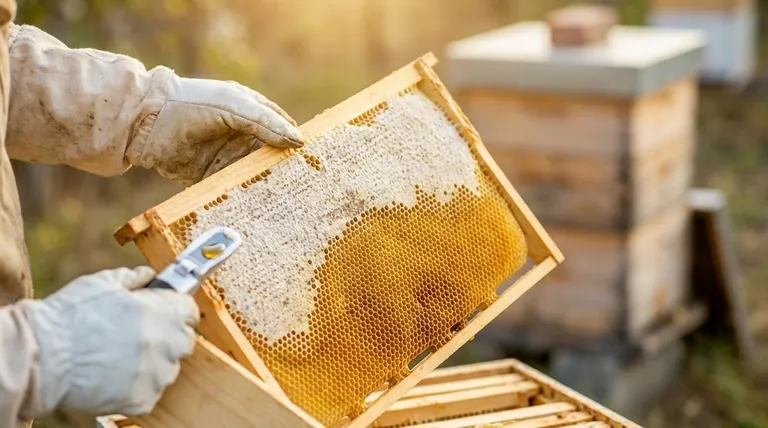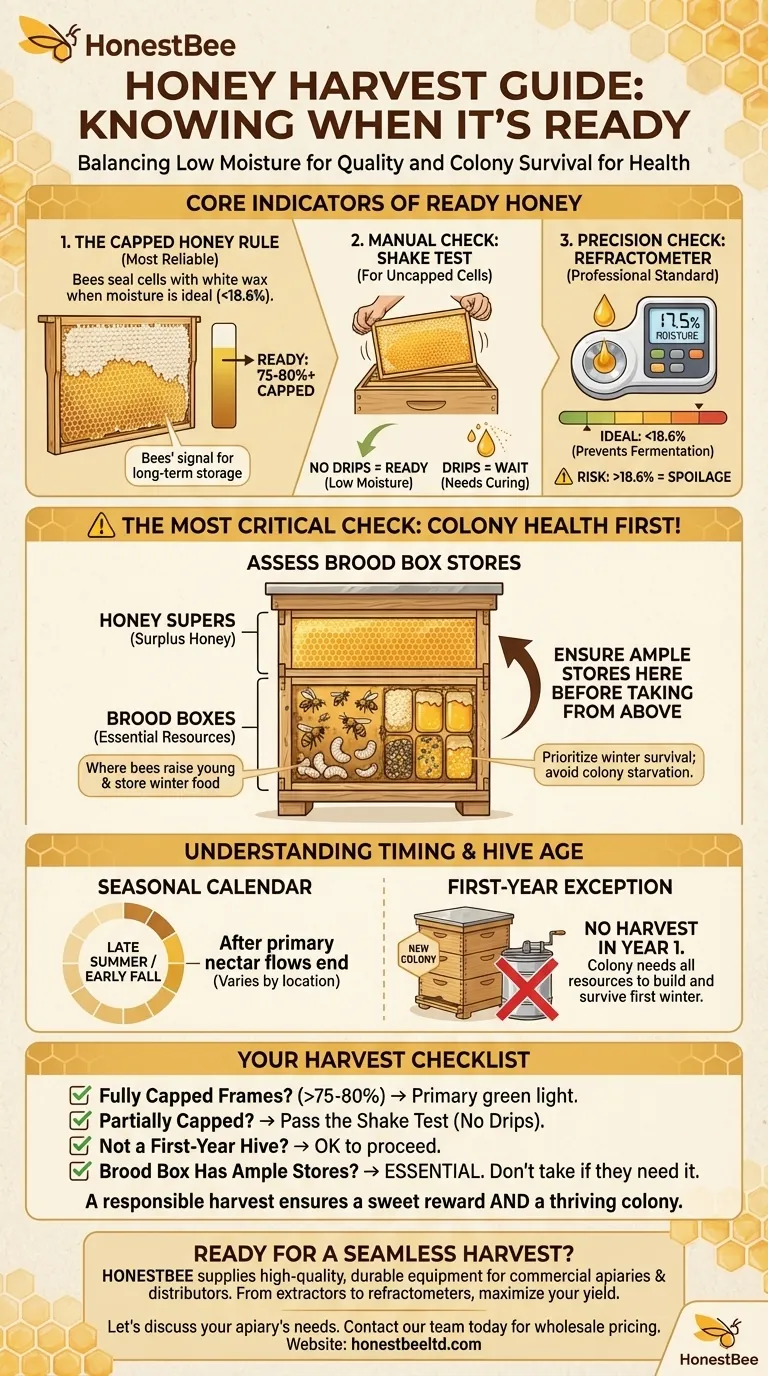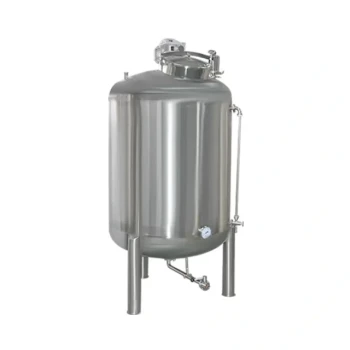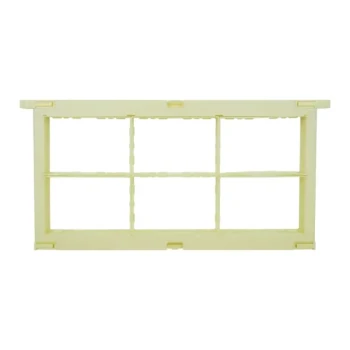The most reliable sign that honey is ready to harvest is when the bees have "capped" the honeycomb with a layer of white beeswax. This capping is the bees' own signal that the honey has been dehydrated to the correct moisture content and is ready for long-term storage.
A successful honey harvest is a balance between two critical factors: ensuring the honey's moisture content is low enough to prevent spoilage and, most importantly, confirming the colony has more than enough honey stored for its own survival.

Core Indicators of Ready Honey
Understanding the signals your bees provide is the key to knowing the perfect time to harvest. These indicators are about moisture, maturity, and the physical state of the honeycomb.
The "Capped" Honey Rule
When bees fill a honeycomb cell with nectar, they fan their wings to evaporate the water content. Once the honey reaches the ideal moisture level (below 18.6%), they seal the cell with a fresh wax cap.
A frame is considered ready for harvest when it is at least 75-80% capped on both sides. Fully capped frames are ideal.
Checking Moisture Manually
For frames with uncapped cells, you must check the moisture content. The simplest method is the "shake test."
Hold the frame horizontally over the hive and give it a firm shake. If honey drips or sprays out, its water content is too high. The bees need more time to cure it.
Using a Refractometer for Precision
For a definitive measurement, a honey refractometer is the professional standard. This device measures the precise water percentage in a drop of honey.
Harvesting honey with a moisture content above 18.6% risks fermentation, which will spoil your entire harvest.
The Most Critical Check: Colony Health
Before you even think about taking honey, you must assess the hive's own resources. A beekeeper's first responsibility is to the health of the colony.
Assess the Brood Box First
The honey supers on top of the hive are for surplus honey. The brood boxes below are where the bees raise their young and store their essential food for winter.
Before harvesting from the supers, you must inspect the brood boxes. If they do not have ample stores of honey for the bees themselves, you cannot harvest.
Leave Enough for Winter
Taking honey from the supers when the brood chamber is empty can lead to the colony starving over the winter. Always err on the side of leaving too much honey for the bees.
Understanding the Timing
General timing is helpful, but it's always secondary to the specific conditions within your hive and local environment.
The Seasonal Calendar
Most honey harvests occur in the late summer or early fall, after the primary nectar flows have ended. This timing can vary significantly based on your local climate and flowering seasons.
The First-Year Exception
It is a standard rule of beekeeping to not harvest any honey from a hive in its first year. A new colony needs all its resources to build comb, grow its population, and survive its first winter.
Your Harvest Checklist
Use these points to make a confident and responsible decision.
- If you see fully capped frames: This is your primary green light. The honey is cured and ready for extraction.
- If you see partially capped frames: Perform the shake test. If no honey drips out, it is likely safe to harvest.
- If it's your hive's first year: Do not harvest. Your goal is to ensure the colony is strong enough to survive the winter.
- Before every harvest: Always check the brood box first. If the bees don't have enough food for themselves, you cannot take their surplus.
Ultimately, a responsible harvest ensures both a sweet reward for you and a healthy, thriving colony for years to come.
Summary Table:
| Key Indicator | What to Look For | Why It Matters |
|---|---|---|
| Capped Honeycomb | At least 75-80% of cells sealed with white wax. | Bees' signal that honey is cured (moisture <18.6%). |
| Shake Test | No honey drips when frame is shaken firmly. | Indicates low enough moisture to prevent fermentation. |
| Brood Box Stores | Ample honey reserves in the brood chamber. | Ensures colony health and survival before you harvest surplus. |
| Season & Hive Age | Late summer/fall harvest; no harvest in first year. | Aligns with natural nectar flows and supports new colony establishment. |
Ready for a seamless and productive honey harvest?
A successful harvest relies on having the right equipment. HONESTBEE supplies commercial apiaries and beekeeping equipment distributors with high-quality, durable supplies through our wholesale-focused operations. From honey extractors and uncapping tools to refractometers and storage containers, we provide everything you need to maximize efficiency and yield.
Let's discuss your apiary's needs. Contact our team today to learn more about our products and wholesale pricing.
Visual Guide

Related Products
- 6 Frame Manual Stainless Steel Honey Extractor Beekeeping Equipment
- HONESTBEE 3-Frame Manual Acrylic Honey Extractor
- 0.5T Capacity Honey Dehumidifier Dryer with Vacuum Heating and Thickening Filtering Machine
- 8-Frame Electric Self-Reversing Honey Extractor Spinner for Commercial Honey Extraction Equipment
- 2 Frame Stainless Steel Manual Honey Spinner Extractor for Beekeeping
People Also Ask
- What are the key stages of honey extraction? A Complete Guide for Beekeepers
- What is the basic principle of the honey extractor? Harness Centrifugal Force for Efficient Harvesting
- Which type of extractor is more suitable for hobbyists or small-scale beekeepers? Find the Perfect Fit for Your Apiary
- What type of honey extractor is best? Maximize Your Harvest Efficiency with the Right Choice
- What are some tips for using a honey extractor effectively? Maximize Your Honey Yield and Protect Your Comb



















